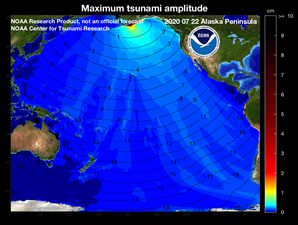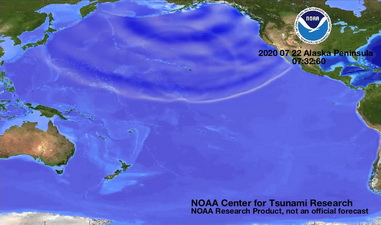|
NOAA NCTR research product
Not an official forecast |
Alaska Peninsula Tsunami, July 22, 2020
Main Event Page
|
The July 22, 2020, Alaska Peninsula, AK tsunami was generated by a Mw 7.8 earthquake (55.068°N 158.554°W), at 2020-07-22 06:12:44 UTC (according to the USGS). The earthquake generated a relatively small tsunami that arrived approximately 20 minutes later at the closest DART 46403, located approximately 295 km away from the epicenter. The proximity of DART 46403 to the epicenter resulted in the tsunami signal being contaminated by seismic noise and unusable for tsunami inversion. While DART 46403 has DART 4G capabilities, meaning it should have been able to filter the tsunami signal from the seismic noise, those capabilities were not activated at the time of the event. The next available DART buoy to detect the tsunami was DART 46402, showing a maximum wave amplitude in deep water just over 0.5 cm approximately 45 minutes after the earthquake. A DART inversion was performed with data from this buoy. Model results shown below were created with the NOAA forecast method using the MOST model via automatic inversion of the source with NOAA's TFS (Tsunami Forecast System). The graphics display preliminary modeling analysis, showing qualitative and quantitative information about the tsunami, including tsunami wave interaction with ocean floor bathymetric features, and neighboring coastlines. Tsunami model amplitude information is shown color-coded according to the scale bar.
Preliminary Model Comparison of the July 22, 2020 Alaska Peninsula tsunami inverted from tsunameter/DARTs data and from USGS finite-fault solution is compared in the graphics with recorded data. Tsunami propagation solutions from DART gauges was computed on the fly while the tsunami was still progressing whereas the finite fault solution was generated after the event. The presented DART-inverted solution was obtained as a linear combination of the sources that best fits the tsunami records from 3 DARTs, 46402, 46408, and 46409.
It is noted that all above model results are preliminary. The tsunami source is estimated from inversion of observed waveforms at DARTs using limited number of unit sources. The discrepancies between model results and observations are primarily due to the inability to use DART 46403 for inversion as data from that system would have contained the largest wave amplitudes. |
||||
Disclaimer: The models on these pages show the results of ongoing research to enhance tsunami science and to improve NOAA operational tsunami forecasts. These products were developed during or shortly after the tsunami event, are intended for research use, and are not an official forecast. They should not be used as the basis of any public or private policy decisions. Please contact NCTR to find if there are more detailed follow-on analysis results.
For media inquiries:
When using information from this page, please credit NOAA / PMEL / Center for Tsunami Research


